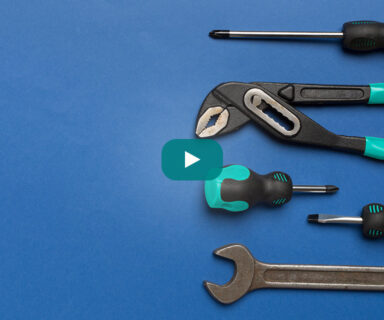Every buyer has an email address, but with inboxes overflowing, the challenge for marketers isn’t just reaching an audience but engaging them effectively. For demand gen emails, this means capturing your reader’s interest and driving them to take action through compelling copy, high-value offers and concise CTAs – all with the goal of moving prospects into the sales funnel.
Fortunately, email marketing is a democratic system. As Jay Schwedelson, CEO and Founder of Subjectline.com, GURU Media Hub and Outcome Media, puts it: “… the inbox is an equal playing field … you have the same exact space as Apple does, as IBM does, as Salesforce does, as the NFL does.” Each business has an equal opportunity to make an impact.
With this in mind, the task at hand becomes creating meaningful, relevant and scalable email campaigns that stand out in a sea of sameness. Let’s break down the core elements of an email and the proven tactics to craft compelling, high-performing messaging that feels personal, even in a 1-to-many environment.
Subject line: The first impression
Subject lines single-handedly determine whether your email is opened or ignored. You can have the best body copy, CTA and visuals, but none will matter if the recipient never opens the email.
Before writing an email subject line (or any email copy really), it’s important to clearly identify “who” you’re talking to – a process most often done through audience segmentation. This ensures you’re delivering a relevant message to the right audience.
“The sooner you can tell somebody who they are, the quicker it is that they want to engage.”
— Jay Schwedelson, The Anatomy of a Killer Demand Gen Email
Marketers can improve their subject lines by telling recipients how they are segmented. Use data points like job function, company, company size, industry and more to craft subject lines that are tailored to your audience segments.
Examples of using audience segmentation information to personalize email subject lines
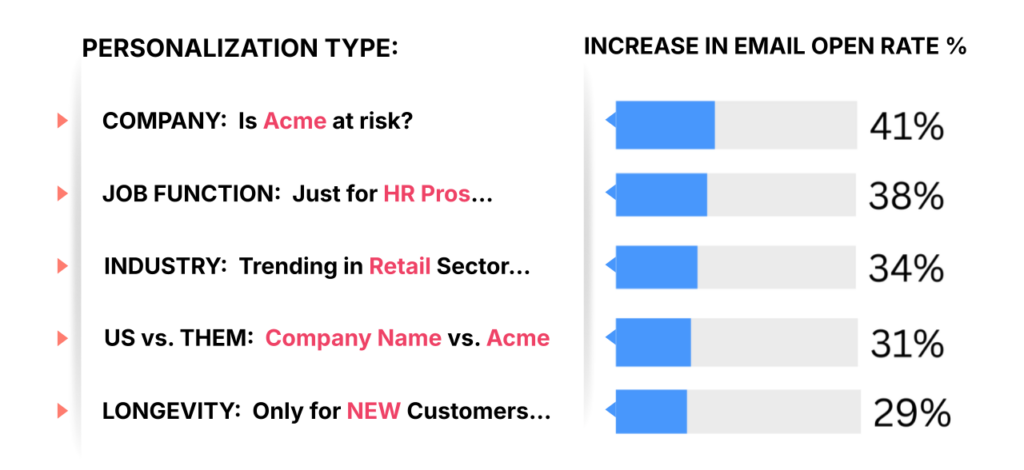
Source: Outcome Media
The once clever but now basic approach of including a recipient’s name in the subject line isn’t cutting it anymore. Good personalization is about telling the recipient who they are, at scale. As much as marketers would love to write a personalized, 1:1 email every time, it’s just not realistic.
The challenge is to bring the same level of personalization to a 1:many message. Even as AI becomes more capable of supporting personalization efforts and marketers become more technologically savvy, the perfect solution hasn’t been found – yet. But there are several strategies out there to increase readability and open rate.
B2B subject line tactics: Last 90-days open rate increase
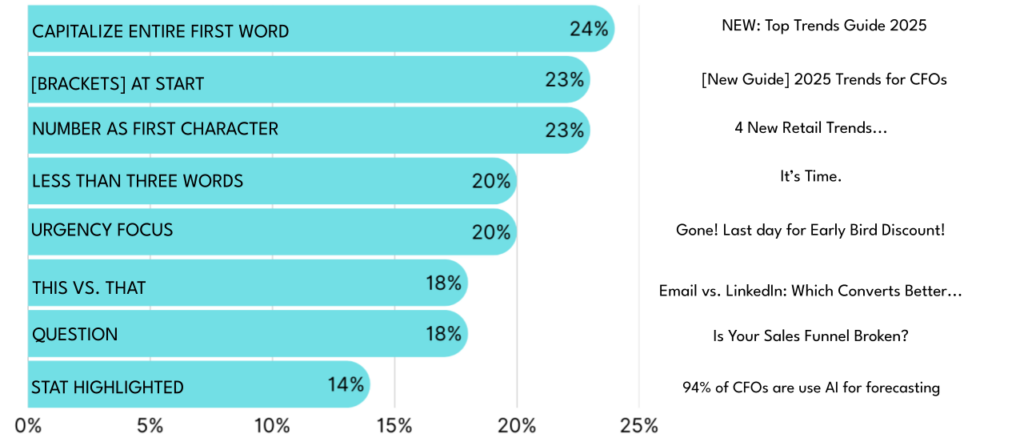
Source: Worldata Research 90 Days Engagement Recap 10/24-1/25
According to Jay and research his team ran at Outcome Media, there are many subject line tactics that can improve open rates, but these are the top four:
- Capitalizing the entire first word – In a crowded inbox, this draws immediate attention to your subject line. For example, “NEW: 2025’s Funniest Marketing Campaigns So Far” is more visually striking than a subject line written in sentence-case.” is more visually striking than subject line written in sentence-case.
- Placing brackets around the first word or phrase – Brackets provide context to your subject line in a concise way, such as “[Webinar] Why Classic Content Captivates Audiences.” In this example, the reader immediately has the crucial details from the subject line alone.
- Having a number be the first character – Numbers make the subject line of the email digestible. For instance, “Three B2B Video Trends Marketers Should Watch,” sets clear expectations for the reader in a compelling way.
- Using less than three words – Short subject lines create intrigue and cut through the inbox clutter. For example, “Last Chance,” “Exclusive” or “You’re Invited.”
Take the tactics above, apply them to your email marketing program and test to see what is successful for you.
Event email promotions: First word of subject line open rates drop by:
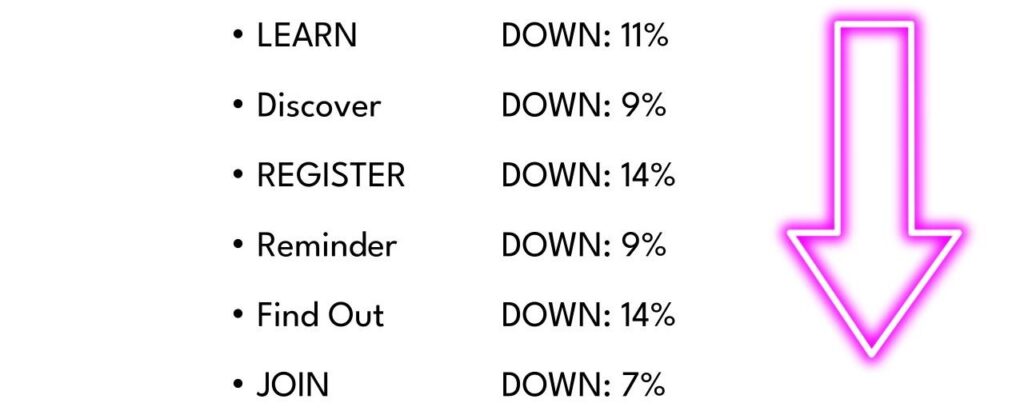
Source: Worlddata Research 2024 Performance Report
While there are strategies to employ, there are also words and phrases Jay recommends to avoid. Take words like “learn,” “discover” and “join” for example. Did somebody say lackluster, drab and just overdone? You might as well have. Starting your email subject lines with overused words or phrases like these can depress email open rates.
To keep your emails fresh, perform an audit of your past subject lines to spot patterns in word choice that increase open rates and those that decrease engagement. A/B testing can help you further identify what words resonate best with your audience. When in doubt, swap in more action-oriented, curiosity-driven language that feels timely and specific to your audience.
And finally, don’t be afraid to be bold. Some marketers hesitate to personalize too much, fearing they might come off as “creepy.” But the key is relevance. If your email references past behavior, like website activity, or details from a form they filled out, such as industry, most consumers will see the personalization as relevant rather than intrusive.
Content and offers: Provide value
Once your email is opened, it’s time to prove it was worth it to your reader by providing them value. A compelling offer or engaging content is what keeps readers interested. Take into account what offers or content formats drive the most engagement from your audience in emails, according to Schwedelson.
To do this, analyze past email performance to see which content types and formats resonate most with your audience, closely looking at click-through-rates to identify what drives the highest engagement.
Email content/offers ranked by percent increase in click-through vs. generic product offer
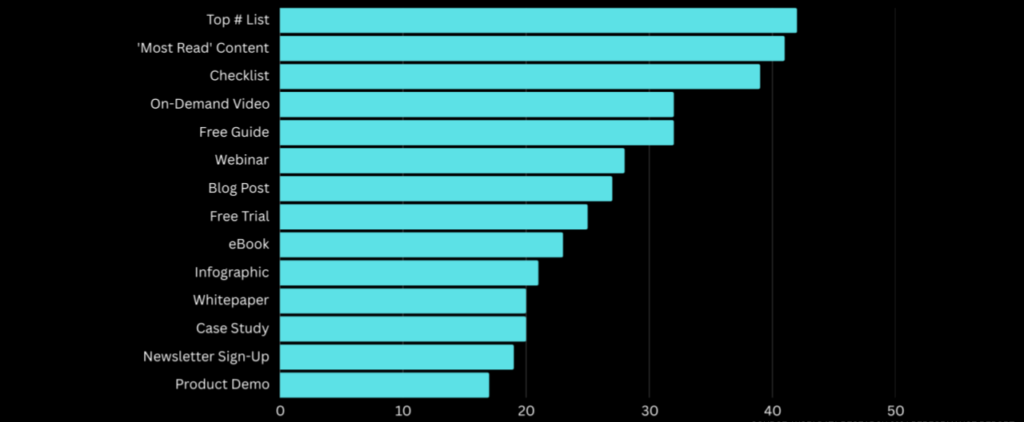
Source: Worlddata Research 2024 Performance Report
According to Jay and the research his team ran at Outcome Media, the top five email content formats that garner the most clicks are:
- Top # list – This format promises a structured and digestible way to gain insights. An asset titled “Top 50 Content Marketing Brands of 2024” instantly sparks curiosity and sets expectations for readers for what they’ll get from the content.
- “Most read” content – If a recipient’s peers are engaging with content, they’ll likely assume it will provide value for them too. Consider an offer like “Our most read article this month.” This signals credibility and compels the reader to be in the know about what everyone else is reading.
- Checklist – Similar to a “top # list,” checklists are tactical and practical, making them highly appealing to professionals. Take “ESG Content Strategy: An Essential Checklist for the Reflective Marketer” for example. This tells the reader exactly what to expect and delivers immediate value.
- On-demand video – Videos are a top format for B2B and B2C and marketers because they are engaging and require minimal effort from the audience, especially if they can watch it whenever they want.
- Free guide – An offer like “Download the Free Guide: Designing a Comprehensive Intent Data Strategy” implies value with no cost or risk, increasing the likelihood of a click.
Increase in registration rate in head-to-head test of “webinar” vs. “alternate name”
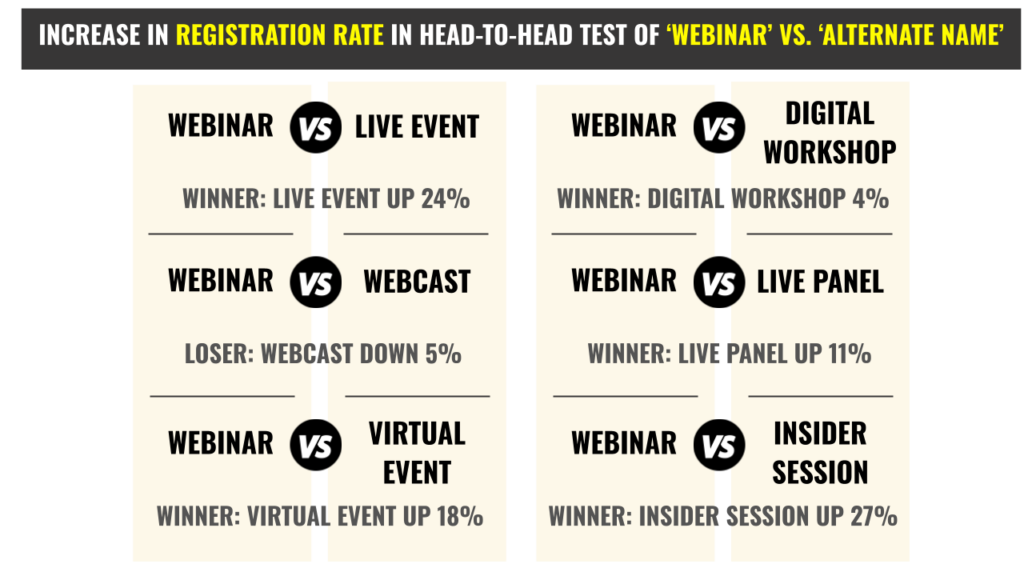
Source: Worlddata Research 2024 Performance Report
Finally, experiment with how you frame your content. For example, does a “Insider Session” sound more exciting than a “Webinar”? In the case of Schwedelson’s research, it did. Although this feels like a small change, it can make all the difference in email conversions.
“If email doesn’t work for you, it’s because you’re not looking at the little things. This is what matters.”
— Jay Schwedelson, The Anatomy of a Killer Demand Gen Email
To find what resonates best with your audience, run A/B tests on subject lines, headlines, body copy and CTAs. Split your audience into test groups and track open rates, click-through rates and conversions to see which wording drives the most engagement.
Call to action: Seal the deal
Your call to action is the bridge between the email, content and connecting with your audience. Let’s dig into a few ways to get your audience to cross the bridge and click.
One effective tactic is directly referring to the reader in the first person. Take, for example, an email with the CTA “Register” vs. “Save my spot.” The second option is more compelling for the reader because it creates a sense of ownership with their click.
“When your call-to-action buttons are written in first person, believe it or not, it will lift your click-through rates by over 28%.”
— Jay Schwedelson, The Anatomy of a Killer Demand Gen Email
Next, don’t shy away from long(er) CTAs. Full-sentence CTAs can be more effective than one-word commands. Consider the difference between “Download” and “I want top HR tips.” The ladder speaks directly to the audience and feels more conversational (bonus points for personalization).
The Moral of the Story: Test, Test, Test
What works for others might not be best for your audience. The key is to continuously test, reiterate and optimize. Take it from Jay, “Don’t ever be nervous about testing something that doesn’t go well. Because who cares? Move on to the next one.”
By focusing on meaningful personalization, refining your subject lines, crafting compelling offers and using conversion-driving CTAs, you can build high-performing email campaigns to engage your audience and spur results.
For more insights on how to supercharge your email marketing, watch The Anatomy of a Killer Demand Gen Email.

